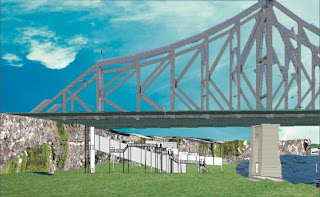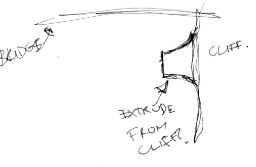Wednesday, 13 June 2012
Final Drawings - Sections
Thursday, 7 June 2012
Friday, 1 June 2012
Design features
Speaker room in ferry terminal for waiting
passengers. Plug headphones into the wall to hear different music and sounds.
Listening Posts act as supporting posts for the
pods. Plug headphones to hear sound from the space above.
Tuesday, 29 May 2012
Tuesday, 22 May 2012
Natural sound development sketches
I wanted the natural sound space to react and
interact with the site. Because of this I looked at having glass that reflects
the natural curve of the river and by setting the pod against the cliff face.
Silence Space development sketches
I wanted this pod to reflect its program and be very
simple and neutralising. Hence the use of a simple square shape. Because the
space needs to be sound proof, it is not possible to have windows. The
insulation is very involved with textures being vital to the performance.
 |
| Section through the building showing textures |
 |
| Flat walls bounce sound back, textured walls absorb sound. |
 |
| Example of textures |
Wednesday, 16 May 2012
Composed Sound - Sound Hall/Theatre
The sound hall is a space to experience composed
sound; music. It is here that visitors of the building can passively experience
sounds that are created with a distinct purpose. It shall take the form of a
general theatre as there has been much research over centuries in the best way
to acoustically experience sound.
No sound – Silence space
An anechoic room is a room that absorbs sound and
doesn’t produce any echoes. This is something that I learnt researching sound
and think it would be an interesting thing for people to learn about in the
space. The silence space could include this as a sound testing space or
recording studio. For the general public it could also be a place for
relaxation and reflection in close proximity to the CBD. Obviously, for a space
to be sound proof there needs to be many technologies implemented, examples of
projects are shown below:
Natural Sounds - acoustic ecology
Natural sounds, also known as acoustic ecology,
are sounds of natural elements (wind etc), as well as natural sounds to the
area (this would include traffic and human noises etc). The natural sound space will use elements to reflect
natural sounds surrounding the space to the area. It will also feature elements
to mimic natural sounds. These are some examples:
 |
| Sways in the wind and mimics natural sounds |
 |
| Echoes sound |
 |
| Area sound is coming from to the site |
Visualising sounds - cymatics
The visualising sound space is in my opinion the
most exciting. This space will greatly rely on the use of speakers as this is a
major element that influences visual sound. Here are a few examples of cymatic
activities:
 |
| Example of how speaker system works |
 |
| cornstarch and water activated by sound |
 |
| Patterns made by salt/rice/flour by sound |
 |
| 3D prototype model of sound waves |
 |
| Video feed captures cymatics and displays it on screens |
Subscribe to:
Comments (Atom)







































